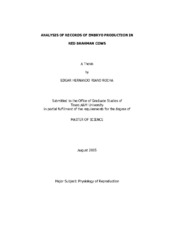| dc.description.abstract | Records of embryo production in Red Brahman donor cows (n=50) and F1
recipients (n=531) were evaluated from the collection day to the birth of the
embryo produced. The effects of the sire of the donor and the embryo, protocol,
season-protocol, and body condition of the donor on the total number of good,
degenerated, unfertilized, and total embryos were evaluated. The number of
donors collected for protocols 1, 2, and 3 were 50, 39, and 46 respectively. The
production of good transferable embryos, and embryos/collection for protocols 1,
2, and 3 were 171 (4.6), 152 (4.6), and 208 (6.3) respectively. The final status
of each recipient was recorded as non-pregnant, resorption, abortion, and live
calf. The model used to analyze pregnancy state was: protocol, embryo stage,
embryo quality, corpora lutea size, and season. The effects of sire of the embryo,
season-protocol, protocol, embryo stage, embryo quality, body condition score,
and corpora lutea size on gestation length and birth weight were analyzed.
Season-protocol affected (P<0.05) the number of degenerated embryos. Mean
number of degenerated embryos were higher (P<0.05) during winter for
protocols 2 and 3 than during other seasons. The ratio for good embryos differed
(P<0.01) by sire of donor.
The final status of recipients was affected (P<0.01) by protocol. The maximum
percentage of live calves and the minimum percentage of non-pregnant
recipients were achieved for protocol 3. Gestation length differed (P<0.01) by sire of the embryo, season-protocol,
protocol, and body condition score. Spring-protocol 3 resulted in the shortest
while Fall-protocol 2 resulted in the longest mean gestation length. Calf birth
weight differed (P<0.05) by season-protocol and by embryo quality. The lightest
birth weights resulted from embryo quality grade 2 and from spring-protocol 3.
These results indicate that using protocols that combine 17??-estradiol, FSH
and GnRH (protocol 3) during the spring in conjunction with selection for sire of
donor can increase embryo production by Red Brahman cows. Use of protocol 3
with donors in the spring, selection of embryo sire for short gestation length and
transfer of quality grade 2 embryos can be used to minimize the incidence of
dystocia in recipients. | en |


